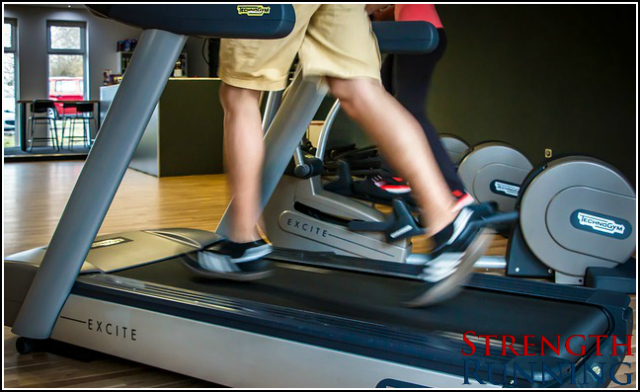The human hamster wheel. The dreadmill. Satan’s conveyor belt. Is there any doubt that most runners despise the treadmill?

Running on a treadmill is an unfortunate reality for many runners during the winter and summer months. Just think of everything you have to run through:
- Frigid temperatures
- High heat and humidity
- Slippery roads
- Snow drifts
- Unbearable sun
Sometimes, running on a treadmill is often the safest (and more comfortable) alternative to running outside.
But there’s a reason we hate it: it’s so boring!
Since a treadmill is sometimes the only choice, it makes sense to have fun with your workouts. After all, the faster sessions in a training program are what help you improve your speed, economy, and ultimately your race performances.
So if you’re stuck inside on the dreadmill, use these three workouts to reduce the boredom of running inside.
Instead of passively watching television or staring at a wall in your basement, these are designed to increase engagement with the run itself – so you can have more fun and gain fitness at the same time.
Workout #1: “Boil the Frog”
There’s an old saying that if you place a frog in boiling water, she’ll jump right out to save herself. But if you put her in lukewarm water and gradually raise the temperature, she won’t even notice the slowly escalating temperature of the water.
While this particular piece of folklore has been proved false, we can still model a workout after it.
To start, run at an easy pace for ten minutes. After you’re warmed up, increase the pace by about 5-10 seconds per mile every 3 minutes based on the length of your run.
You can make this workout more difficult by also increasing the incline of the treadmill by .5% as well.
After several miles of increasing pace and incline, reverse the order and slowly transition back to your easy pace and the starting incline.
Now, you’re not a frog. You’ll definitely notice the increasing difficulty of this run – which is called a progression. It can be used in place of more traditional tempo or marathon-paced runs and is a great session for runners training for the marathon or half marathon.
The real benefit of a workout like this is to teach runners to run fast when they’re tired. Running fast on fresh legs is easy – but can you keep running faster and faster with mounting fatigue?
It’s a critical skill and one that will serve you well during your next race.
Workout #2: The Running Power Hour
Remember back in college when you put on your Power Hour CD for an hour and took a shot of beer every minute? Those were the days!
Today you’ll be playing a healthier version: take that same CD or playlist (with sixty 1-minute songs) and run a workout based on that playlist on the treadmill.
Instead of drinking beer every minute (there are smarter ways to hydrate), you’ll be alternating between fast and slow paces.
This type of workout is traditionally called a fartlek – Swedish for speed play. First, make sure you warm up with some dynamic stretches and at least 10 minutes of easy running.
When the playlist starts, you alternate between a comfortable pace and a faster pace. The beauty of this workout is that there’s flexibility to run as fast as you want: from as fast as the treadmill goes, to 5k pace or marathon pace.
The main benefit of the running power hour is the ability to change paces frequently. This often happens in race situations so it’s valuable to practice during training as well.
And the side benefit? You get to listen to sixty (abbreviated versions) of your favorite songs!
Workout #3: iPod Roulette
Warning: this can be a challenging treadmill workout. It’s great for runners who want to run faster but don’t have a lot of time.
The first step is to make a playlist of about ten songs that are each about three minutes long. Make sure that half the songs are upbeat, high intensity songs and half of them are more mellow.
Start the workout with a warm-up routine and at least 10 minutes of easy running. Set your playlist on random or shuffle and you’re ready to go! When an upbeat song starts, run fast. When a mellow song starts, run slow.
Don’t be fooled: this workout will test you. Occasionally, you’ll run fast for two or more songs in a row, meaning you’ll have to pace yourself and be a bit more cautious than you would for a running power hour session.
Choose to run at the following paces:
These paces are far more manageable than more challenging mid-distance paces. And since you may be running “fast” for 5-10 minutes at a stretch, it’s wise to be more conservative.
This workout teaches the brain to handle and accept uncertainty. Too often we run structured workouts where we know exactly what’s coming.
But in a big race, you may not know when your competitor is planning a surge or when the next big hill will appear.
Get comfortable with the uncomfortable feeling of uncertainty – and you’ll race faster.
Running through poor weather on a treadmill is nowhere near as fun as running outside with the sun shining on your face. But these engaging treadmill workouts can help spice up your training when it’s too uncomfortable or dangerous to venture outside.
Finally, a question for you: What’s your favorite treadmill workout? Leave it in the comments below!
Note: a version of this article first appeared on Competitor.